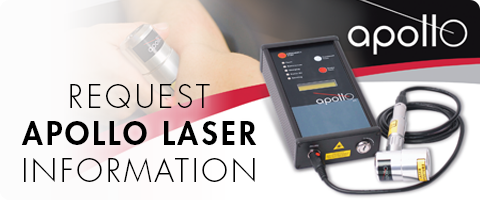This article excerpt, by Dr. Alexandra K. Schnee, was originally published on spine-health.com and can be found here.
Cold Laser Therapy or Low Level Laser Therapy is a treatment that utilizes specific wavelengths of light to interact with tissue and is thought to help accelerate the healing process. It can be used on patients who suffer from a variety of acute and chronic conditions in order to help eliminate pain, swelling, reduce spasms and increase functionality.
How Cold Lasers Work
Cold lasers, like the Apollo Cold Laser, are handheld devices used by the clinician and are often the size of a flashlight. The laser is placed directly over the injured area for 30 seconds to several minutes, depending on the size of the area being treated and the dose provided by the cold laser unit.
During this time, the non-thermal photons of light that are emitted from the laser pass through the skins layers (the dermis, epidermis, and the subcutaneous tissue or tissue fat under the skin). This light has the ability to penetrate 2 to 5 centimeters below the skin at 90mw and 830 nm.
Once the light energy passes through the layers of skin and reaches the target area, it is absorbed and interacts with the light sensitive elements in the cell. When cells absorb this light energy, it initiates a series of events in the cell that is theorized to eventually result in normalizing damaged or injured tissue, a reduction in pain, inflammation, edema and an overall reduction in healing time by increasing intracellular metabolism.
Cold laser therapy can stimulate all cell types including muscle, ligament, cartilage, nerves, etc., so a number of conditions can be treated by cold laser therapy. Some of conditions that may typically be treated by cold laser therapy include:
- Arthritis pain
- Back pain
- Carpal tunnel syndrome
- Fibromyalgia pain
- Knee pain
- Neck pain
- Tendonitis
Effectiveness of Cold Laser Therapy
For years, physicians have been using cold laser therapy on patients who are seeking effective, alternative methods for pain relief. Since 1967 there have been over 2,500 clinical studies published worldwide. Many of these studies are double-blinded, placebo-controlled and have demonstrated cold laser therapy to be a proven method for pain relief.
However, many of these studies were done with small groups, so further larger studies need to be completed. For example, one issue that needs to be studied further is that there does not appear to be a uniform standard regarding the dose and number of treatments.
The effectiveness of cold laser therapy for neck pain was recently reviewed by The Bone and Joint Decade 2000-2010 Task Force on Neck Pain, an initiative conducted by a multidisciplinary team of researchers and clinicians.
The task force concluded that low-level laser therapy can be a beneficial treatment for certain types of neck pain, including types of pain that cause little or no interference with daily activities and pain the does limit daily activities, as compared to pain that includes radiculopathy (arm pain) or serious pathology.3
Cold Laser Therapy has been used in clinical practice all around the world for over four decades. In 1916, Albert Einstein conceived the theory of Light Amplification through Stimulated Emission of Radiation or LASER. In 1967, Professor Andre Mester began using low power lasers in medicine. Dr. Mester is recognized by many as the grandfather of laser therapy.
F.D.A Recognition of Cold Laser Therapy
The F.D.A classifies medical lasers into three categories:
- Class 4 Surgical Lasers
- Class 3B Non-surgical Lasers
- Class 3A Low-Level Lasers
Class 4 Surgical Lasers are used to cut, coagulate, and vaporize tissue. This is different from Class 3B and Class 3A non-surgical lasers, which are painless, non-burning, and non-cutting forms of lasers. Class 3B or Class 3A Low Level Lasers do not have the intensity to damage cells. Class 3A lasers help heal superficial wounds and conditions and will typically not penetrate below the skin’s surface. However, Class 3B low level lasers have the ability to penetrate and assist in the healing process of deep tissue and joint problems.
The first experimental FDA clearance of Class 3B Lasers occurred in February of 2002, after a successful study for carpal tunnel syndrome on workers at General Motors. The laser that was used had a power of 90mw at 830nm.
Certain low level laser devices are also FDA approved for relief of the following conditions:
- Muscle and joint pain
- Stiffness associated with arthritis
- Pain associated with muscle spasms
- Hand pain and wrist pain associated with Carpal Tunnel Syndrome
- Neck pain
- Lower back pain
- Wound healing
Potential Cold Laser Therapy Advantages
Cold laser therapy is a non-invasive procedure, meaning that it does not require a surgical incision. This means that there is no prolonged recovery time.
Laser therapy also does not involve taking any medications, and many patients prefer to avoid taking medications. Studies have so far found that cold laser therapy does not have serious side effects when used properly by a doctor.
Potential Cold Laser Therapy Disadvantages
Patients do not typically get full relief or resolution from their pain symptoms after the first treatment. It takes a series of treatments, usually 8 to 30, depending on the severity and duration of the condition.
Patients often have to return to the doctor for treatments at least 2 to 4 times per week. Old injuries may be aggravated for a few days after treatments, but for most patients this sensation is short term, lasting for a couple of days.
Medicare and Medicaid do not cover cold laser therapy expenses. Some major medical insurance carriers do assist with payment and others do not cover any of the treatment.
Contraindications
Cold laser therapy should not be used over any suspicious cancerous lesions, or carcinoma, over the thyroid, on pregnant patients, and there should not be direct irradiation of the eyes, as the laser can cause permanent damage to the eyes.
Pregnant women are recommended not to undergo the procedure, since its effects on unborn children are not yet known. The doctor and the patient should use protective eyeglasses so that there is no direct eye exposure.
Cold laser therapy is one option among a variety of treatment approaches that can potentially provide pain relief or pain reduction, especially for patients seeking a treatment without the use of surgery or drugs.
It can be used alone or in combination with a number of other therapies.
While it is still a relatively new treatment option and there is incomplete information about its optimal treatment protocol, it is considered a viable treatment option for those seeking an alternative to invasive treatment.
Cold laser therapy is yet another method in the set of tools to help assist in pain relief, and it is considered a reasonable treatment option for certain types of pain by most health care professionals.
This article was originally published in Spine-Heath.com and can be found here.
Are you interested in learning more about cold laser therapy and it's benefits? Click below to request more information about the Apollo Laser Cold Laser.


